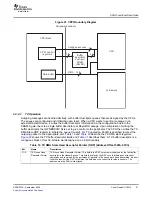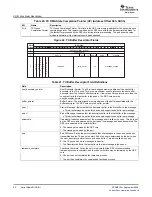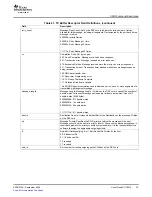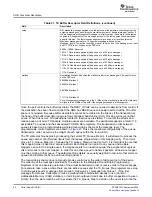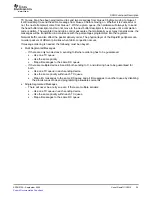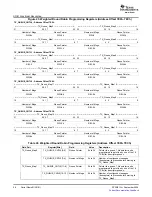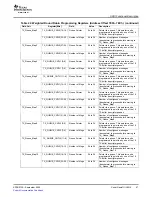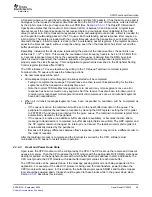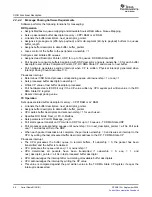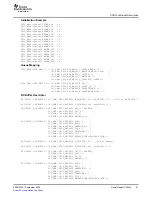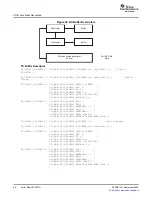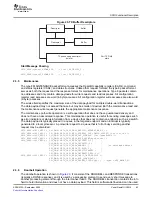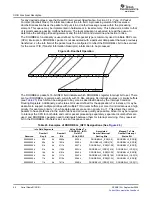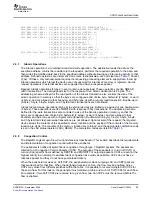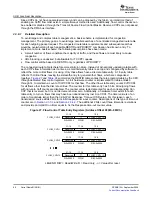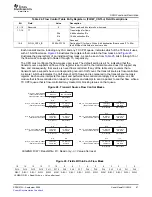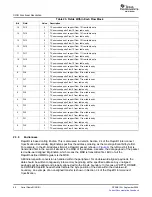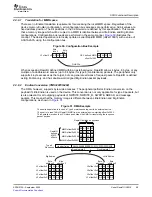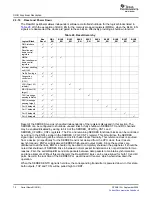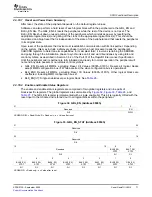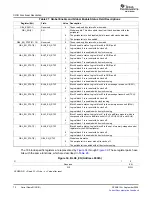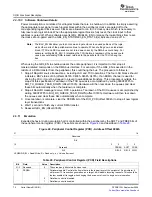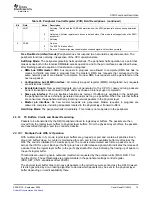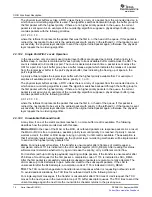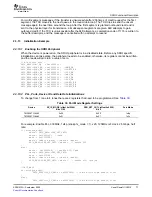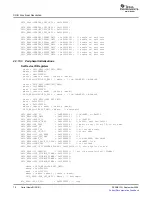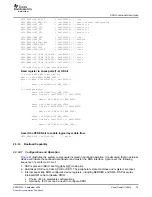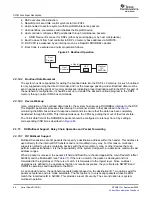
www.ti.com
2.3.7
Atomic Operations
2.3.8
Congestion Control
SRIO Functional Description
SRIO_REGS->LSU1_REG0 =
CSL_FMK( SRIO_LSU1_REG0_RAPIDIO_ADDRESS_MSB,0 );
SRIO_REGS->LSU1_REG1 =
CSL_FMK( SRIO_LSU1_REG1_ADDRESS_LSB_CONFIG_OFFSET, 0);
SRIO_REGS->LSU1_REG2 =
CSL_FMK( SRIO_LSU1_REG2_DSP_ADDRESS, 0);
SRIO_REGS->LSU1_REG3 =
CSL_FMK( SRIO_LSU1_REG3_BYTE_COUNT, 0 );
SRIO_REGS->LSU1_REG4 =
CSL_FMK( SRIO_LSU1_REG4_OUTPORTID,1 )
|
CSL_FMK( SRIO_LSU1_REG4_PRIORITY,0 )
|
CSL_FMK( SRIO_LSU1_REG4_XAMSB,0 )
|
CSL_FMK( SRIO_LSU1_REG4_ID_SIZE,1 )
|
CSL_FMK( SRIO_LSU1_REG4_DESTID,0xBEEF )|
CSL_FMK( SRIO_LSU1_REG4_INTERRUPT_REQ,0 );
SRIO_REGS->LSU1_REG5 =
CSL_FMK( SRIO_LSU1_REG5_DRBLL_INFO,0x0000 )|
CSL_FMK( SRIO_LSU1_REG5_HOP_COUNT,0x03 )
|
CSL_FMK( SRIO_LSU1_REG5_PACKET_TYPE,type );//type = DOORBELL
The Atomic operation is a combination read and write operation. The destination reads the data at the
specified address, returns the read data to the requestor, performs the required operation to the data, and
then writes the modified data back to the specified address without allowing any intervening activity to that
address. Defined operations are increment, decrement, test-and-swap, set, and clear (see
Table 3
, Packet
Type). Of these, only test-and-swap requires the requesting processing element to supply data. Incoming
Atomic operations which target the device are not supported for internal L2 memory or registers. Atomic
request operations to external devices are supported and have a response packet.
Request Atomic operations (Ftype 2) never contain a data payload. These operations are like NREAD
(24h) transactions. The data payload size for the response to an Atomic transaction is 8 bytes. The
addressing scheme defined for the read portion of the Atomic transaction also controls the size of the
atomic operation in memory so that the bytes are contiguous and of size byte, half-word (2 bytes), or word
(4 bytes), and are aligned to that boundary and byte lane as with a regular read transaction. Double-word
(8-byte), 3-byte, 5-byte, 6-byte, and 7-byte Atomic transactions are not allowed.
Atomic test-and-swap operations (Ftype 5) to external devices are limited to a payload of one double-word
(8 bytes). These operations are like NWRITE with response (55h) transactions. The addressing scheme
defined for the write transactions also controls the size of the Atomic operation in memory so that the
bytes are contiguous and of size byte, half-word (2 bytes), or word (4 bytes), and are aligned to that
boundary and byte lane as with a regular write transaction. Double-word (8-byte), 3-byte, 5-byte, 6-byte,
and 7-byte Atomic test-and-swap transactions are not allowed. Upon receipt of the request, the targeted
device swaps the contents of the specified memory location and the payload if the contents of the memory
location are all 0s. The contents of the memory location are returned, and the appropriate completion code
is set in the LSU status register (LSUn_REG6). The completion codes are listed in
Table 15
.
The RapidIO Logical Layer Flow Control Extensions Specification. This section describes the requirements
and implementation of congestion control within the peripheral.
The peripheral is notified of switch fabric congestion through type 7 RapidIO packets. The packets are
referred to as Congestion Control Packets (CCPs). The purpose of these packets is to turn off (Xoff), or
turn on (Xon) specific flows defined by DESTID and PRIORITY of outgoing packets. CCPs are sent at the
highest priority in an attempt to address fabric congestion as quickly as possible. CCPs do not have a
response packet and they do not have guaranteed delivery.
When the peripheral receives an Xoff CCP, the peripheral must block outgoing LSU and CPPI packets
that are destined for that flow. When the peripheral receives an Xon, the flow may be enabled. Since
CCPs may arrive from different switches within the fabric, it is possible to receive multiple Xoff CCPs for
the same flow. For this reason, the peripheral must maintain a table and count of Xoff CCPs for each flow.
For example, if two Xoff CCPs are received for a given flow, two Xon CCPs must be received before the
flow is enabled.
SPRUE13A – September 2006
Serial RapidIO (SRIO)
65
Submit Documentation Feedback

